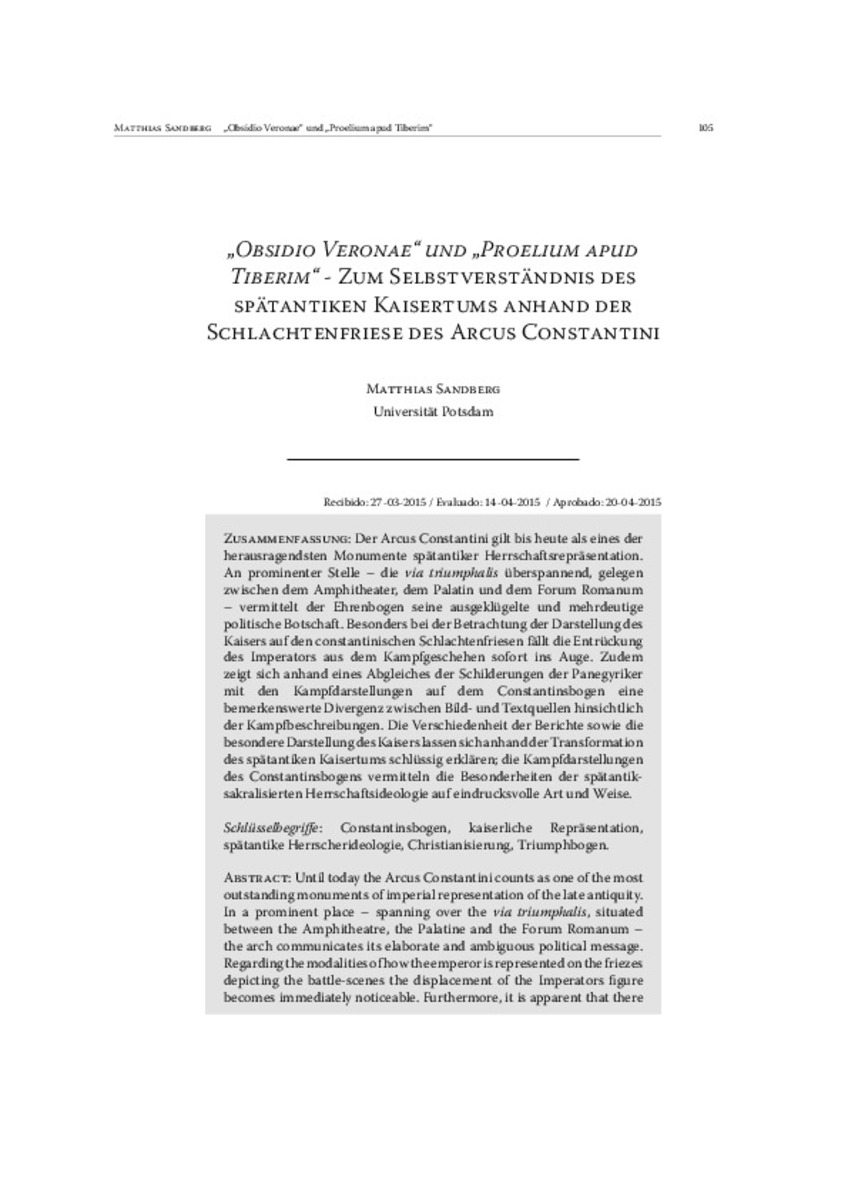Mostrar el registro sencillo del ítem
"Obsidio Veronae“ und „proelium apud Tiberim" - Zum Selbstverständnis des spätantiken Kaisertums anhand der Schlachtenfriese des Arcus Constantini
| dc.contributor.author | Sandberg, Matthias | |
| dc.date.accessioned | 2017-04-28T11:45:58Z | |
| dc.date.available | 2017-04-28T11:45:58Z | |
| dc.date.issued | 2015 | |
| dc.identifier.citation | SANDBERG, Matthias. "Obsidio Veronae “und „proelium apud Tiberim"-Zum Selbstverständnis des spätantiken Kaisertums anhand der Schlachtenfriese des Arcus Constantini. Potestas. Estudios del Mundo Clásico e Historia del Arte, 2015, no 8, p. 105-148. | ca_CA |
| dc.identifier.issn | 2340-499X | |
| dc.identifier.issn | 1888-9867 | |
| dc.identifier.uri | http://hdl.handle.net/10234/167313 | |
| dc.description | Until today the Arcus Constantini counts as one of the most outstanding monuments of imperial representation of the late antiquity. In a prominent place – spanning over the via triumphalis, situated between the Amphitheatre, the Palatine and the Forum Romanum – the arch communicates its elaborate and ambiguous political message. Regarding the modalities of how the emperor is represented on the friezes depicting the battle-scenes the displacement of the Imperators figure becomes immediately noticeable. Furthermore, it is apparent that there is a divergence between the picture- and the text-sources respectively the commentaries of the panegyrists concerning the battle-reports. e difference between both can be explained with the transformation of the late antique empire. e battle scenes of the arch of Constantine communicate the characteristics of imperial representation in late antiquity in an impressive manner. | ca_CA |
| dc.description.abstract | Der Arcus Constantini gilt bis heute als eines der herausragendsten Monumente spätantiker Herrschaftsrepräsentation. An prominenter Stelle – die via triumphalis überspannend, gelegen zwischen dem Amphitheater, dem Palatin und dem Forum Romanum – vermittelt der Ehrenbogen seine ausgeklügelte und mehrdeutige politische Botschaft. Besonders bei der Betrachtung der Darstellung des Kaisers auf den constantinischen Schlachtenfriesen fällt die Entrückung des Imperators aus dem Kampfgeschehen sofort ins Auge. Zudem zeigt sich anhand eines Abgleiches der Schilderungen der Panegyriker mit den Kampfdarstellungen auf dem Constantinsbogen eine bemerkenswerte Divergenz zwischen Bild- und Textquellen hinsichtlich der Kampfbeschreibungen. Die Verschiedenheit der Berichte sowie die besondere Darstellung des Kaisers lassen sich anhand der Transformation des spätantiken Kaisertums schlüssig erklären; die Kampfdarstellungen des Constantinsbogens vermitteln die Besonderheiten der spätantik- sakralisierten Herrschaftsideologie auf eindrucksvolle Art und Weise. | ca_CA |
| dc.format.extent | 43 p. | ca_CA |
| dc.format.mimetype | application/pdf | ca_CA |
| dc.language.iso | deu | ca_CA |
| dc.publisher | Universitat Jaume I. Departamento de Historia, Geografía y Arte | ca_CA |
| dc.relation.isPartOf | Potestas Estudios del Mundo Clásico e Historia del Arte, 2015, no. 8 | ca_CA |
| dc.rights.uri | http://creativecommons.org/licenses/by-sa/4.0/ | * |
| dc.subject | Constantinsbogen | ca_CA |
| dc.subject | kaiserliche repräsentation | ca_CA |
| dc.subject | spätantike herrscherideologie | ca_CA |
| dc.subject | Christianisierung | ca_CA |
| dc.subject | Triumphbogen | ca_CA |
| dc.subject | Arch of Constatine | ca_CA |
| dc.subject | imperial representation | ca_CA |
| dc.subject | late antique imperial ideology | ca_CA |
| dc.subject | Christianisation | ca_CA |
| dc.subject | triumphal arch | ca_CA |
| dc.title | "Obsidio Veronae“ und „proelium apud Tiberim" - Zum Selbstverständnis des spätantiken Kaisertums anhand der Schlachtenfriese des Arcus Constantini | ca_CA |
| dc.type | info:eu-repo/semantics/article | ca_CA |
| dc.identifier.doi | http://dx.doi.org/10.6035/Potestas.2015.8.5 | |
| dc.rights.accessRights | info:eu-repo/semantics/openAccess | ca_CA |
| dc.relation.publisherVersion | http://www.e-revistes.uji.es/index.php/potestas/article/view/2312 | ca_CA |
Ficheros en el ítem
Este ítem aparece en la(s) siguiente(s) colección(ones)
-
Potestas_2015_ no.8 [12]








